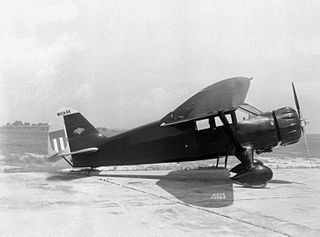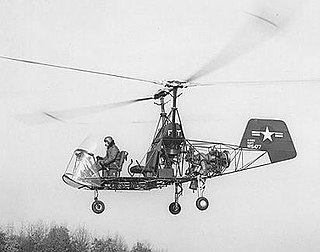
The Saab 91 Safir is a three or four seater, single engine trainer aircraft. The Safir was built by Saab AB in Linköping, Sweden and by De Schelde in Dordrecht, Netherlands.

The Stinson 108 was a popular general aviation aircraft produced by the Stinson division of the American airplane company Consolidated Vultee, from immediately after World War II to 1950. It was developed from the prewar Model 10A Voyager. Stinson was bought by Piper Aircraft in 1949. All Stinson model 108, 108-1, 108-2, 108-3 and 108-4 aircraft were built by Stinson at Wayne, Michigan. When Stinson sold the type certificate to Piper in 1949, approximately 325 airplanes of the 5,260 model 108s built by Stinson were complete but unsold. These 325 model 108s went to Piper as part of the sale. Piper then sold that inventory as the Piper-Stinson over the next few years.

The Piper PA-18 Super Cub is a two-seat, single-engine monoplane. Introduced in 1949 by Piper Aircraft, it was developed from the Piper PA-11, and traces its lineage back through the J-3 to the Taylor E-2 Cub of the 1930s. In close to 40 years of production, over 10,000 were built. Super Cubs are commonly found in roles such as bush flying, banner towing and glider towing.

The Stinson Reliant is a popular single-engine four- to five-seat high-wing monoplane manufactured by the Stinson Aircraft Division of the Aviation Manufacturing Corporation of Wayne, Michigan.

The Piper PA-12 Super Cruiser is an American three-seat, high wing, single-engine conventional landing gear-equipped light aircraft that was produced by Piper Aircraft between 1946-48. The PA-12 was an upgraded and redesignated Piper J-5.

The Fairchild XNQ was an American trainer designed as a standard primary trainer for the United States Navy during the 1940s.

The Call-Air Model A is an American two- to three-seat utility aircraft designed by the Call brothers and built by the Call Aircraft Company, later developed into a successful line of agricultural aircraft.

The Stinson Voyager was a 1940s American light utility monoplane built by the Stinson Aircraft Company.

The Colonial Model C-1 Skimmer was an American small single-engined amphibian flying boat built by the Colonial Aircraft Corporation. It was the start of a line of very similar aircraft designed by David Thurston.

The CNNA HL-6 was a civil trainer aircraft developed in Brazil in 1943.

The Goodyear GA-2 Duck was a 1940s American three-seat light amphibious aircraft built by the Goodyear Aircraft Corporation. The design team included David Thurston, who later developed several other light seaplanes including the Colonial Skimmer, Lake Buccaneer, Thurston Teal and Seafire. Only 19 aircraft were built, and these were used only for testing and as demonstrators.

The Kaman K-225 was an American experimental helicopter developed by Kaman Aircraft. One example was modified to become the world's first gas turbine-powered helicopter.

The Stearman XBT-17 was a prototype 1940s American two-seat low-wing monoplane primary trainer designed and built by Stearman Aircraft. It was evaluated by the United States Army Air Force in 1942 as the XBT-17.

The Ameur Altania was a single-engine light aircraft of pusher configuration with side-by-side seats for two and a V-tail, designed in France in the 1990s. Several prototypes were built and flown, including a 15 m span motorglider version; the final prototype was constructed from carbon composites rather than glass fibre. Another version, the UCA Carbon Bird has been built by Universal Composite Aviation after the bankruptcy of Ameur Aviation.

The Partenair Mystere is a Canadian two-seat, pusher configuration monoplane that was designed by Partenair Design of Saint-Jean-sur-Richelieu, Quebec and intended for amateur construction from kits.

The Kawasaki KAT-1 is a Japanese primary trainer, seating two in tandem, designed to compete for a Japanese Air Defense Force (JADF) contract in the mid-1950s. Only two were completed.

The Fleetwings BQ-1 was an early expendable unmanned aerial vehicle — referred to at the time as an "assault drone" — developed by Fleetwings during the Second World War for use by the United States Army Air Forces. Only a single example of the type was built, the program being cancelled following the crash of the prototype on its first flight.

The Fleetwings BQ-2 was an early expendable unmanned aerial vehicle — referred to at the time as an "assault drone" — developed by Fleetwings during the Second World War for use by the United States Army Air Forces. Only a single example of the type was built; the aircraft was deemed too expensive for service and was cancelled after a brief flight testing career.
The Franklin O-300 was an American air-cooled aircraft engine of the early 1940s. The engine was of six-cylinder, horizontally-opposed layout and displaced 300 cu in (5 L). The power output ranged between 130 hp (97 kW) and 175 hp (130 kW) depending on variant. The 6ACG-298 featured a geared propeller drive.
Morrow Aircraft Corporation was American aircraft and aerospace manufacturing company founded by Howard (Spud) Morrow, and opened on April 1,1941 in San Bernardino, California. Morrow Aircraft factory designed and built the Model 1-L tandem two-seat trainer for Civilian Pilot Training Program. Morrow Aircraft used a plastic bonded plywood construction for the body and was powered by a Lycoming O-435 engine. The Model 1-L was also called the Victory Trainer. The factory was at the Municipal Airport, San Bernardino, now Norton Air Force Base. Designed by Edgar Schmued who also worked on the North American P-51 Mustang. The Victory Trainer prototype was built, but not used for the World War 2 effort. The Victory Trainer wing and tail resembled that of the P-51 Mustang, so the plane was called the Little Mustang by some.


















